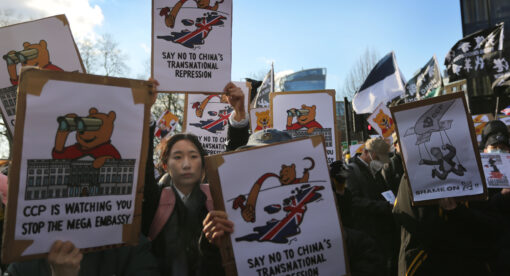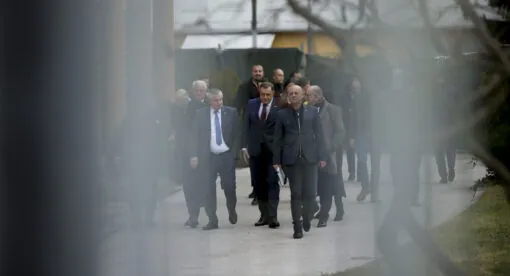The recent U.S. attempts to reach a negotiated solution with Iran over its nuclear enrichment program combined diplomatic outreach with belligerence, leading to a predictable failure of its goal. Even as it invited Iranian negotiators to the bargaining table, the U.S. continued to employ threats, military force, and coercion against the Islamic Republic in a return to ineffective tactics of the past. It also did not prevent Israel from playing spoiler to those talks by launching its own attacks on Iran in a move contrary to U.S. strategic interests.
Although the U.S. soon joined its ally in direct action, targeting Iran’s underground nuclear facilities, there is little evidence that its bombing raids destroyed them. While the show of force may have set back Iran’s program, it did not extinguish its nuclear ambitions. Instead, it justified them, empowered the Islamic Revolutionary Guard Corps (IRGC), and increased the likelihood that Tehran will one day cross the nuclear threshold to weaponization.
If Washington wants to fulfill its objective to prevent proliferation, stabilize the Middle East, and score a major diplomatic win, it must abandon coercion as the primary tool of statecraft and pivot to a framework of strategic reciprocity. Offering credible security assurances and reintegration to Iran in exchange for verifiable limits on its nuclear program and regional activities represents a way forward.
Additionally, the U.S. must decouple its policy from Israeli maximalism by leveraging its influence to halt unilateral Israeli escalations that sabotage diplomacy. A modernized diplomatic framework, akin to an expanded Abraham Accords that incentivizes coexistence over confrontation, offers U.S. President Donald Trump the chance for a legacy-defining achievement. But this can only be accomplished through a refined diplomatic approach that eschews the use of force to attempt to bend the will of a revolutionary state.
When Trump returned to office, his administration signaled clear intent to establish a “verifiable nuclear agreement” with Tehran. While he had maintained a willingness to return to the “maximum pressure” campaign from his first term, it was evident he was looking to be seen as a dealmaker. Oman, a longstanding intermediary, quietly facilitated a series of talks between both parties.
That process began to fracture when negotiations stalled over a critical issue: The United States demanded that Iran not only cease enrichment beyond civilian thresholds but also “give up” the entirety of its nuclear program, something Tehran refused to do, citing its rights under the Non-Proliferation Treaty (NPT). The impasse was real but not yet fatal to a deal as more talks had been scheduled in Rome. Then came the sharp rupture, when Israel launched a series of direct strikes against Iranian military and nuclear infrastructure two days before talks were to resume.
Iran immediately accused Israel of deliberately sabotaging diplomacy and declared further negotiations with Washington would remain frozen until Israeli operations ceased. For Israel, which has long opposed any agreement that left any Iranian nuclear program intact, the calculus was evident: undermine diplomatic efforts and in doing so, narrow the space for U.S. engagement. Public sentiment in Israel reflected this push, with the appearance of the narrative urging Trump to “finish the job,” implying that Israeli operations were designed, at least in part, to pressure the United States into more direct involvement.
In Washington, the political ramifications were challenging; the Trump administration, already contending with criticism over its failed diplomacy in Ukraine and Gaza, was now confronted with the optics of strategic paralysis. Thus, Faced with Israeli escalation and subverted negotiations, Trump recalibrated, giving the go-ahead for heavy ordnance strikes on three Iranian nuclear facilities: Fordo, Isfahan, and Natanz. The attacks caused “extremely severe damage” according to initial assessments. While Vice President JD Vance insisted that the United States is “not at war with Iran, we’re at war with Iran’s nuclear program,” the boundary has already been crossed: U.S. forces struck Iran, and the world is waiting to see what happens next.
What began as an interest in resolving the nuclear issue through negotiation has now transformed into a campaign of escalation because of Israel’s actions and the consequent recalibration of American strategy. The U.S. has traversed this path numerous times, yielding minimal significant gains. If the objective is to create a new diplomatic framework that can limit Iran’s nuclear development, military strikes are counterproductive. A policy of escalation to incentivize de-escalation only complicates the situation and makes revolutionary states like Iran with a strong distrust of its adversaries, less inclined to participate.
Attempting it once again risks strengthening the Islamic Revolutionary Guard Corps (IRGC), legitimizing Tehran’s nuclear program, and deepening animosity toward the United States. If Trump is truly intent on securing a meaningful, lasting “win” vis-à-vis Iran, the U.S. must abandon the coercive strategies of the past in favor of a fundamentally different approach, one that recognizes the complexity of Iran’s strategic calculus and seeks to redefine the parameters of engagement accordingly.
The History of Iran’s Nuclear Program
To understand what factors influence the strategies of all parties, it’s imperative to examine the historical foundations and events that have affected each. Achieving a meaningful deal requires an understanding of the backgrounds of each actor and their relative objectives and concerns.
Iran’s nuclear development program found its roots in the U.S.-backed “Atoms for Peace” initiative, and it has evolved over the decades, shaped by historical events, strategic imperatives, and regional tensions. The origins of mistrust for the United States are found in the 1953 CIA-led coup, which ousted Prime Minister Mohammad Mossadegh and reinstated Shah Mohammad Reza Pahlavi. The 1979 Islamic Revolution that toppled the shah preceded the hostage crisis at the U.S. Embassy that severed all diplomatic ties, reciprocating a threat perception for the West. The revolution also sparked the animosity between Israel and Iran after Iran declared Israel an enemy of Islam, engaged in proxy warfare, and started efforts to support the Palestinian cause.
By the early 2000s, the International Atomic Energy Agency (IAEA) had raised concerns about Iran’s failure to comply with safeguards on nuclear enrichment, causing heavy sanctions and international isolation. Since 2003, Iranian Supreme Leader Ayatollah Ali Khamenei has upheld a fatwa (a religious edict) prohibiting the development of nuclear weapon, although this fatwa is thought to be flexible as political and security realities evolve.
The signing of the JCPOA in 2015, negotiated by the administration of President Barack Obama, marked a turning point in addressing Iran’s nuclear program through diplomatic means. However, the deal faced heavy criticism by its opponents, namely Israel, which claimed Iran was hiding the true extent of its nuclear activities from IAEA inspectors. The deal collapsed in 2018 when Trump withdrew U.S. participation, limiting the IAEA’s monitoring capabilities. After the U.S. departure, Iran resumed nuclear enrichment and development.
However, despite being considered a “threshold state,” the fatwa remains in place, and Iran has still refrained from weaponizing its nuclear technology, according to U.S. intelligence assessments.
Understanding Iran’s Nuclear Strategy
Iran’s nuclear ambivalence is equally intertwined with the IRGC’s strategic culture as it is with Khamenei’s operational code. To contextualize the logic underpinning Iran’s nuclear strategy, both must be considered.
The IRGC is not just a military body; it is a state within a state. It was born out of the 1979 revolution with the goal of regime defense at any cost and its doctrine of subversion and asymmetric warfare was forged during the Iran-Iraq War. In the last 30 years, the IRGC has amassed extensive control over Iran’s military, economy, political, and foreign policy as well as proxy networks throughout Iraq, Syria, Lebanon, and Yemen.
The IRGC sees deterrence as multi–domain. Ballistic missiles, proxy forces, cyber operations, and nuclear ambiguity are not redundant; they are interwoven components of an asymmetric deterrent doctrine. For the IRGC, the nuclear program is less about offensive military utility than deterrent value, particularly from the U.S. and its allies, who are perceived as a direct threat.
When negotiations falter or when attacks occur, the IRGC’s response is not simply retaliatory, it is systematic. Escalation justifies the expansion of the security state, silences reformist voices, and further entrenches the IRGC’s dominance. Consequently, U.S. and Israeli strikes, while aimed at weakening Iran’s capabilities, instead empower its most powerful faction.
Khamenei’s stance is more complicated. His position is frequently portrayed in Western analysis as that of a virulent ideologue, which is more narrative than truth. He sits as the head of a revolutionary regime with a deep-seated mistrust of the West, but he remains one of the cooler heads within the regime with a more pragmatic approach to statecraft. However, while the supreme leader retains formal control of the state, he relies on the IRGC to enforce ideological order and project power abroad. Khamenei is aware of the risks of letting the IRGC go unchecked: a more militant, less internationally palatable state prone to reckless escalation. This is one of the fallacies of Western idealization of regime change: The ayatollah is one of the stabilizing factors in Iran, keeping the IRGC in check.
Khamenei has always stood firm on his nuclear fatwa, which, according to former Iranian diplomat Amir Mousavi, may evolve depending on the circumstances. Specifically, the fatwa on nuclear weaponization is shaped by the principle of maslahat-e nezam (regime expediency), allowing for flexibility when it comes to the survival of the regime. With this logic, while the fatwa may currently restrict Iran’s nuclear program to civilian uses, an existential threat such as a significant military intervention or attempt at regime change, could alter the prohibition.
Importantly, Iran does not believe the U.S. seeks an earnest settlement. The JCPOA withdrawal, international isolation, assassinations, cyberattacks, and now direct military strikes and talk of regime change have all affirmed a central belief: Diplomatic engagement with the West is transactional, fragile, and ultimately unreliable.
Given Iran’s decades-old nuclear program, if it was interested in obtaining a nuclear weapon, it certainly could have done so by now. Consider North Korea, which achieved nuclear breakthrough status in a fraction of the time with a fraction of Iran’s resources and capacity.
Reconciling this logic, it becomes evident that Iran has no interest in breaking the nuclear taboo. Thus, it is logical to infer that there is still a pathway to prevent Iran crossing the threshold. However, further isolation and military attacks will be counterproductive to that endgame, instead increasing the likelihood of Iranian escalation.
The U.S. and Israeli Perspectives
While Iran’s posture is shaped by historical trauma, regime survival, and deterrence logic, the U.S. and Israel operate from a position of sustained dominance tempered by a long history of adversarial and existential threats. The U.S. and Israel play key roles in shaping the trajectory of the Iranian nuclear program and creating the current “facts on the ground.”
American mistrust of the Islamic Republic is a product of the idea of Iran itself; the ideological regime that violently rejected the West, seized a U.S. embassy, and continues to publicly advocate against U.S. influence in the region. Unlike conventional U.S. adversaries, Iran is portrayed as uniquely irrational, uniquely dangerous, and uniquely resistant to the West. That narrative was reinforced in subsequent decades by Tehran’s support for nonstate actors, its anti-Israel rhetoric, and its “Death to America” chants. Even if more political than operational in nature, these factors have still given Iran a place in the “Axis of Evil.”
In practical terms, this has made engagement with Iran difficult to sell domestically. Even when Iran complies, as it did under the JCPOA, the framework remains vulnerable to collapse because the problem is not exclusively one of behavior, but of national identity.
Trump returned to office intent on claiming the mantle of the “ultimate dealmaker.” But Russia has rebuffed Trump’s overtures, believing it is winning the war in Ukraine. In Gaza, Trump was stalled on the Palestinian issue. Iran, therefore, became the remaining theatre in which a “win” could be forged.
Initially, this meant returning to negotiations, strongarming Tehran into a deal that could be repackaged as tougher, better, and more verifiable than Obama’s JCPOA. But as diplomacy faltered, Trump faced a choice: double down on diplomacy and risk looking indecisive at a period of low approval ratings or pivot to confrontation and reassert dominance. He chose the latter, a move made easier by decades of bipartisan suspicion that any Iranian restraint is a temporary tactic, not a transformation.
Israel’s calculus is both simpler and more radical: Iran is seen as not just a threat but an existential one. Since the 1990s, Prime Minister Benjamin Netanyahu has warned that Iran was on the verge of acquiring a nuclear bomb and said the regime intended to attack Israel or the West. Those warnings rarely matched consensus from intelligence agencies, but the political utility of casting Iran as a nuclear threat has endured. The perceived Iranian threat is existential, not necessarily because of Iran’s capabilities but because of its intent: a state that publicly rejects Israel’s legitimacy, supports proxies across Israel’s borders, and commands regional influence far beyond its borders.
The Israeli government has never supported any diplomatic resolution that leaves Iran with any form of nuclear program. Israel opposed the JCPOA from its inception, claiming Iran would use the deal as a cover to advance its nuclear ambitions. While most intelligence assessments (including Mossad’s) found Iran largely compliant in the deal’s early years, the narrative of deceit persisted, in part because the political benefit of casting Iran as an implacable enemy has been so lucrative. Escalation with Iran has given Netanyahu three crucial benefits: It deflected attention from Israel’s military actions in Gaza, it shored up U.S. support, and it provided significant domestic political capital. By highlighting a common existential threat, it has muted internal and external criticism of the government.
As such, undermining any diplomatic process that legitimizes Iran’s nuclear infrastructure becomes a strategic imperative, and the most effective way to do that is to provoke a crisis that discredits diplomacy. The most strikes on Iranian infrastructure, timed days before resumed talks, follow this pattern. Israeli escalation creates a political environment in which American diplomatic objectives appear naive.
However, a key aspect of regional dynamics that must be accounted for is Israel’s own nuclear weapons program, undisclosed, unacknowledged, but widely known. Israel sees its deterrent value as absolute, and affording any other state in the region that capability would upset the balance of power there. Maintaining its strategic monopoly on nuclear weapons in the Middle East reflects a core pillar of its defense doctrine. The emergence of even a latent Iranian deterrent would radically alter the regional balance, not because Iran would use such weapons but because it would constrain Israeli freedom of action and threaten Israeli security dominance.
A Self-Fulfilling Prophecy
Thus, the strategic balance among the United States, Israel, and Iran is not merely complex or flawed but also structurally self-perpetuating. Each party, driven by its own internal logic, ends up validating the fears and strategies of its adversaries. The result is not deterrence but continual entrenchment.
Military strikes historically do not alter the trajectories of revolutionary states but instead reaffirm them. Today’s Iran is nothing like Iraq in 1991; it is technologically more advanced, more decentralized, and already a threshold state. Hitting Fordow or Natanz might hinder the program, but it does nothing to alter its trajectory. To the contrary, hitting Iran confirms the logic of deterrence: that nuclear weapons may be the only guarantor against regime change and foreign interference.
If Iran does cross the nuclear threshold, it will not be because it was always committed to doing so, it will be because it was pushed to do so. Furthermore, if Iran does in fact proliferate, then Israel’s nuclear posture may shift dramatically and regional proliferation will become more likely as several actors, including Saudi Arabia, Türkiye, and Egypt, have expressed that they may consider nuclear deterrence as necessary.
Israeli and U.S. interests in regime change in Iran are not nearly as clean as they are made out to be. Iran has multiple centers of power, a deeply entrenched ideological identity, and a self-sufficient and potent security apparatus. Toppling Khamenei would not bring a return to liberal democracy or another pro-western leader. Instead, it would empower the IRGC to form a military junta, resulting in a more extreme, more militarized state with a greater willingness to engage in nuclear proliferation. After all, the same narrative preceded regime destruction in Iraq, ushering in a decades-long era of instability there.
The U.S. and Israel also have different endgames for Iran. Israel wants to dismantle Iran’s regime, destroy its offensive infrastructure, eliminate its proxy capabilities, and end its regional influence. Trump, by contrast, has clearly been looking for a politically beneficial deal. After all, one theme one theme of his reelection campaign was ending wars, not starting them. However, Israeli escalation is increasingly narrowing U.S. options to the point that although the U.S. claims it is “not at war with Iran,” it threatens extreme consequences in the event of Iranian escalation.
While Iran has expressed an openness to resuming talks, it stipulates that no further attacks occur. However, if Israel elects to undermine negotiations yet again, the situation could quickly devolve into a political quagmire. If the current trajectory remains unchanged, the United States risks finding itself mired in another open-ended conflict it neither asked for nor fully understands. Strategic ambiguity and reactive escalation are not a plan – they’re the absence of one. But there is an alternative, and it begins with halting the spiral.
Policy Recommendations
First, U.S. policy must not be subcontracted to an ally whose endgame is maximalist and whose strategy is openly expansionist. While Israel has the right to defend itself, the U.S. cannot allow Israel to force its hand and should use its military, diplomatic, and financial leverage to press Israel into restraint.
Second, the U.S. should recenter its approach around strategic reciprocity. Iran’s primary foreign policy objectives, foreign noninterference in its domestic politics (including threats of regime destabilization) and global economic and diplomatic reintegration, are not incompatible with U.S. interests. A nuclear deal is still possible, but only if it’s grounded in credible quid pro quo solutions. Tehran halts weaponization and ceases its regional destabilization activities, namely its support for proxy militias. In return, Washington guarantees non-intervention from the U.S. and its allies and supports phased reintegration into the international community. Verification is key, but so is reciprocity; pressure without incentive is a provocation, not a strategy.
Third, this deal must be reframed not just as concerned with nonproliferation but as a more comprehensive solution. Trump wants a legacy-defining win to seal a reputation as a global peacemaker? Rein in Iran’s nuclear program and create a diplomatic solution to one of the most volatile regional rivalries in the modern world. A deal akin to the Abraham Accords in which Iran and Israel, although not allies, recognize that coexistence is less costly than war, offers a solution. If the U.S. could pull this off, Trump would be able to claim one of the greatest diplomatic achievements in modern history, especially considering the context and steady decline of stability in the Middle East.
The views expressed in this article are those of the author and not an official policy or position of New Lines Institute.






